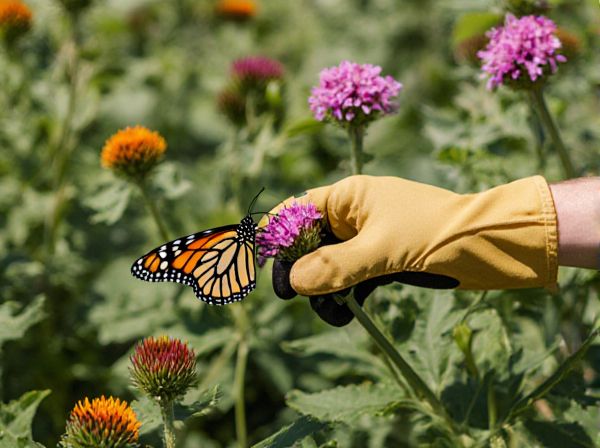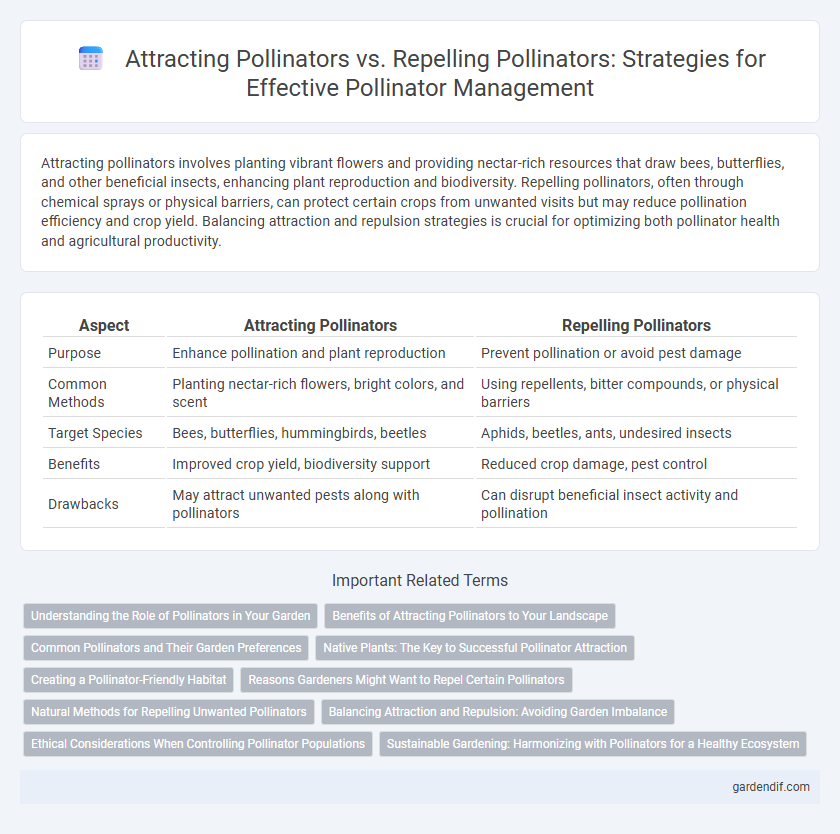
Attracting Pollinators vs Repelling Pollinators Illustration
Attracting pollinators involves planting vibrant flowers and providing nectar-rich resources that draw bees, butterflies, and other beneficial insects, enhancing plant reproduction and biodiversity. Repelling pollinators, often through chemical sprays or physical barriers, can protect certain crops from unwanted visits but may reduce pollination efficiency and crop yield. Balancing attraction and repulsion strategies is crucial for optimizing both pollinator health and agricultural productivity.
Table of Comparison
| Aspect | Attracting Pollinators | Repelling Pollinators |
|---|---|---|
| Purpose | Enhance pollination and plant reproduction | Prevent pollination or avoid pest damage |
| Common Methods | Planting nectar-rich flowers, bright colors, and scent | Using repellents, bitter compounds, or physical barriers |
| Target Species | Bees, butterflies, hummingbirds, beetles | Aphids, beetles, ants, undesired insects |
| Benefits | Improved crop yield, biodiversity support | Reduced crop damage, pest control |
| Drawbacks | May attract unwanted pests along with pollinators | Can disrupt beneficial insect activity and pollination |
Understanding the Role of Pollinators in Your Garden
Attracting pollinators like bees, butterflies, and hummingbirds enhances garden biodiversity and improves fruit and flower production by facilitating cross-pollination. Repelling pollinators can disrupt these essential ecological processes, leading to lower crop yields and reduced plant health. Understanding the role of pollinators helps gardeners implement strategies that balance pest control with maintaining pollinator-friendly environments.
Benefits of Attracting Pollinators to Your Landscape
Attracting pollinators such as bees, butterflies, and hummingbirds to your landscape enhances plant pollination, which boosts fruit and seed production, increasing garden yield and biodiversity. Pollinators contribute to ecosystem health by supporting native plant growth and maintaining ecological balance. Creating habitats with diverse flowering plants rich in nectar and pollen ensures a steady food source, promoting pollinator population sustainability and resilience.
Common Pollinators and Their Garden Preferences
Bees, butterflies, and hummingbirds are common pollinators attracted to vibrant flowers like lavender, coneflowers, and bee balm, which provide ample nectar and pollen. Avoid using pesticides and repellents that deter these beneficial insects, as they prefer native plants and diverse garden ecosystems. Incorporating a variety of flowering plants that bloom at different times maximizes pollinator visits and supports a healthy garden environment.
Native Plants: The Key to Successful Pollinator Attraction
Native plants play a crucial role in attracting pollinators by providing the essential nectar and pollen they need for survival. Unlike non-native species, native plants have evolved alongside local pollinators, ensuring a mutually beneficial relationship that supports biodiversity. Utilizing native plant species enhances garden ecosystems, promoting effective pollination and sustainable pollinator populations.
Creating a Pollinator-Friendly Habitat
Creating a pollinator-friendly habitat hinges on attracting pollinators through native flowering plants, diverse bloom periods, and pesticide-free environments. Repelling pollinators disrupts essential pollination services, reducing biodiversity and crop yields. Optimizing habitat structure with shelter, water sources, and continuous floral resources enhances pollinator visitation and ecosystem resilience.
Reasons Gardeners Might Want to Repel Certain Pollinators
Gardeners may want to repel certain pollinators such as aggressive bees or wasps to reduce the risk of stings and allergic reactions, especially in family-friendly or high-traffic garden areas. Some pollinators can damage specific plants by nesting or feeding on buds and flowers, impacting overall plant health and crop yield. Controlling unwanted pollinators also helps maintain a balanced ecosystem by preventing the dominance of invasive species that disrupt native pollinator populations.
Natural Methods for Repelling Unwanted Pollinators
Natural methods for repelling unwanted pollinators include planting strong-scented herbs like mint, basil, or garlic near vulnerable plants to mask floral scents. Using physical barriers such as fine mesh netting or garden row covers prevents access without harming beneficial insects. Encouraging diverse garden ecosystems with predator-friendly habitats also reduces unwanted pollinator activity by balancing insect populations naturally.
Balancing Attraction and Repulsion: Avoiding Garden Imbalance
Balancing attraction and repulsion of pollinators is crucial to maintaining a healthy garden ecosystem, as excessive repellents can reduce pollination rates, while over-attraction may lead to overcrowding and increased pest presence. Selecting native flowering plants like milkweed and coneflowers boosts pollinator visits by providing essential nectar and habitat without overwhelming the area. Integrating natural repellents such as garlic or neem oil in targeted amounts helps deter harmful insects while preserving beneficial pollinator activity and overall biodiversity.
Ethical Considerations When Controlling Pollinator Populations
Balancing attracting and repelling pollinators requires ethical consideration of ecosystem health and biodiversity preservation. Controlling pollinator populations should prioritize habitat conservation and minimize harm to essential species like bees and butterflies, which support global food security. Ethical strategies involve using non-lethal methods and fostering native plant growth to sustain pollinator services without disrupting natural behaviors.
Sustainable Gardening: Harmonizing with Pollinators for a Healthy Ecosystem
Sustainable gardening practices that attract pollinators, such as planting native flowering species and providing natural habitats, enhance biodiversity and promote ecosystem health. Repelling pollinators through pesticides and habitat destruction disrupts pollination processes, leading to diminished crop yields and ecological imbalance. Harmonizing garden design with pollinator needs supports pollinator populations and ensures long-term environmental resilience.
Attracting Pollinators vs Repelling Pollinators Infographic

 gardendif.com
gardendif.com